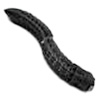| Sep 26, 2025 |
A kirigami-skinned soft robot powered by pneumatic muscles achieves crawling, steering and obstacle avoidance, advancing mobility for confined and rough terrain.
|
|
(Nanowerk News) Limbless animals move across the ground by combining three elements: flexible bodies, rhythmic waves of contraction, and a friction pattern that grips more at the back than the front. This simple formula produces enough thrust for forward movement.
|
|
Inspired by that principle, engineers have built soft robots that crawl through pipes, across rough ground, and even through loose materials. But until now, no design has been able to merge body deformation, friction control, and agile steering into one system.
|
|
Most existing robots face a trade-off. Skins that create directional friction wrinkle and fail when bent, and many machines can only move in straight lines.
|
|
“To overcome these limitations, we develop a multimodal limbless crawling soft robot powered by antagonistic pneumatic muscles and enveloped in a foldable, multistable kirigami skin whose coordinated crease-and-cut architecture maintains stable frictional anisotropy under elongations exceeding 50 % and multidirectional bending,” said researcher Jonathan Tirado. “The robot achieves straight crawling, in-place rotation, and lateral turning, thereby resolving the longstanding trade-off among large deformation, controllable friction, and agile steering in soft crawling robots and furnishing a novel biomimetic mobility platform for confined-space operations such as search-and-rescue operations and pipeline inspection.”
|
 |
| (A) Robot’s body featuring anterior and posterior segments and 2 proximity sensors mounted on its head. (B) Demonstration of different deformation modalities and schematic of inflated chambers. (C) The inner structure of the robot’s body showing the assembly of the foldable kirigami skin and the antagonistic fiber-reinforced inflatable actuator. (D) Geometry of the skin unit cell with black fold lines and red cut lines, and snapshots of the multistable foldable kirigami skin in folded and partially unfolded configurations. (E) External components of the robot, including 3D-printed connectors between the anterior and posterior segments, the kirigami skin, the tail, and the sensorized head housing 2 lateral proximity sensors. (Image: Jonathan Tirado, University of Southern Denmark)
|
|
The robot’s layered design includes a soft body wrapped in foldable kirigami skin. Its front and back segments connect through rigid couplers and contain pairs of fiber-reinforced pneumatic muscles. A single inflation–deflation cycle produces either stretching or bending. Kevlar windings prevent ballooning, ensuring that air pressure translates into controlled movement.
|
|
The kirigami skin, made from a Mylar–Dyneema bilayer, expands in stages when stretched more than 50 percent. This architecture reduces actuation effort, prevents wrinkling, and keeps the crucial “low-front/high-rear” friction profile intact. Its patterned cut lattice spreads loads evenly, boosts grip, and prevents sideways slipping, giving the robot both stability and maneuverability. Twin sensors at the head, linked with a control system, allow it to avoid obstacles and switch movement modes on command.
|
|
Tests showed the robot can crawl straight, steer, and navigate obstacles with reliable performance. On foam surfaces with different pore sizes, it reached speeds of up to 10.83 millimeters per second, with traction increasing on coarser textures thanks to the skin’s stronger grip. The robot pulled greater force on rougher terrain and performed best when the front segment inflated slightly before the back, a sequence that preserved anchoring and maximized thrust.
|
|
Steering trials confirmed that alternating inflation of diagonal chambers allowed the robot to rotate in place. Lower frequencies or three-chamber cycles produced sideways or curved gaits. Equipped with sensors, it avoided obstacles in a test arena and reached its target in under 20 minutes. Across all conditions, the skin maintained directional friction, preventing backsliding.
|
|
These results highlight the strength of combining crease-and-cut skin with pneumatic muscle actuation. The system produced high speeds, reliable traction, agile turning, and consistent performance on complex terrain.
|
|
Still, the robot is not without limits. It requires tethered power and compressed air, restricting its range. Its sensing relies on just two modules, which limits environmental awareness. Certain inflation patterns reduce its friction advantage, and manufacturing tolerances create uneven movement between segments.
|
|
“To address these shortcomings, we suggest optimizing in these areas: hardware augmentation with miniaturized multimodal sensors, development of wear-resistant kirigami materials featuring tunable anisotropic friction, and expanded trials on steeper inclines and broader roughness spectra; control-level upgrades via adaptive navigation and path-planning algorithms to enhance autonomy in unstructured environments; and, at the system level, wireless power delivery combined with onboard pneumatic supply to achieve fully untethered deployment, ultimately targeting demanding scenarios such as search-and-rescue and pipeline inspection,” Tirado said.
|
|
The paper was published in the journal Cyborg and Bionic Systems (“Multimodal Limbless Crawling Soft Robot with a Kirigami Skin”).
|


